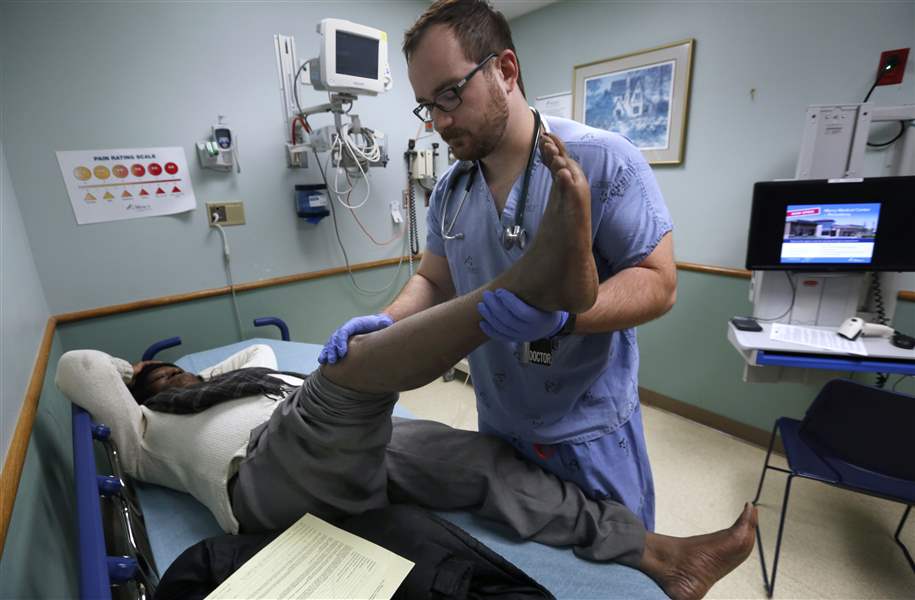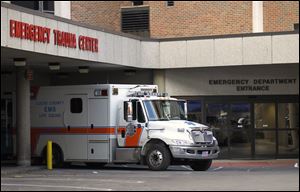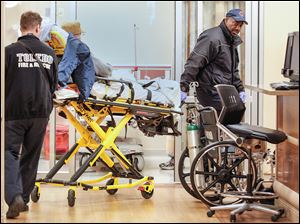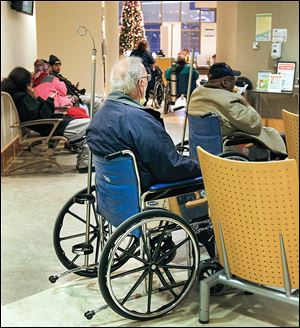
NEW FOCUS ON CUSTOMER SERVICE
Emergency rooms try to free doctors to aid urgent patients
Many nonserious issues seen in local hospitals
1/13/2014
Flora Enoch gets her knee checked out by Dr. William Fogle at Mercy St. Vincent Medical Center in Toledo. ER doctors at Mercy St. Vincent Medical Center treated about 165 patients a day over the last year.
The Blade/Lori King
Buy This Image

Flora Enoch gets her knee checked out by Dr. William Fogle at Mercy St. Vincent Medical Center in Toledo. ER doctors at Mercy St. Vincent Medical Center treated about 165 patients a day over the last year.
Emergency departments at Toledo-area hospitals are caught between two different realities.
PHOTO GALLERY: Area Emergency Rooms
There is a renewed focus on customer service as emergency rooms strive to make themselves as attractive as possible to potential patients. At the same time, emergency room doctors and administrators hope changes in the nation’s health-care system will move some of the poorest patients away from the pattern of turning to the busy ER for help — instead of visiting a private doctor.
There are three Level 1 trauma ERs in Toledo.
ProMedica Toledo Hospital, which is one of the busiest, treats on average 250 patients per day, with an annual increase of about 2 percent to 3 percent. This year, it expects the number of patients to top 93,000, said Beth Estep, clinical director of the emergency department.
The numbers are similar at Mercy St. Vincent Medical Center, where emergency room doctors treated about 165 patients a day, or 68,000 total this last year.
“If you look back over the last five years, there has been a steady increase of about 2 percent per year, with a spike in 2012,” said Dave Wellons, senior director of patient care.
The University of Toledo Medical Center, formerly the Medical College of Ohio Hospital, is the smallest Level 1 trauma center in the area. About 37,000 patients were treated in its emergency room in 2011.
People often don’t realize how much time emergency room doctors spend on primary care in the ER, said Dr. William Fogle, an ER physician at St. Vincent.
The emergency department has 54 beds and is divided into different areas, one for children, one for trauma cases, and the main area where most patients are treated.

An ambulance at Mercy St. Vincent Medical Center in Toledo is parked after dropping off a patient. Mercy St. Vincent is one of three Level 1 trauma ERs in the city.
Issues not serious
“People are coming in with headaches and dental problems,” he said. “I wish there was a way I could spend more time dealing with the seriously ill patients.”
Dr. Fogle recently was in the midst of treating a 32-year-old Toledo woman with a history of chronic pancreatic disease that he said had likely flared up.
“She comes to the ER about once a month,” he explained.
“We are doing God’s work. We are an inner-city hospital and we are going to help people when they come. We are taking the poor and sick that nobody else will see,” he said.
As Dr. Fogle continued his rounds in the ER, he shared another frustration that he and other emergency doctors see regularly. He thinks some primary care doctors are often too quick to tell their patients to go to the ER.
He stopped in another room just a few doors away to examine 60-year-old Flora Enoch, who came to the hospital because she was feeling pain in her knee.
Ms. Enoch said she had a knee replacement about a year ago and has been struggling with pain ever since. She said her regular doctor's office was closed on this day and the on-call physician advised her to seek help at the emergency department.
ER doctors would love for patients to use the service in a more selective way, said Harold Pollack, a public health policy researcher at the University of Chicago.
“You go to school to learn how to fix gunshot victims and then you spend all your time on people with relatively minor complaints,” he said.
Dr. Kris Brickman, chairman of emergency medicine at UTMC, agreed with the other experts.
“Universally, there is not a single person that enjoys the patient coming in complaining about chronic pain saying the dog ate my prescription and I need another refill. This is what we are used to hearing day in and day out. With that being said, some of these people do have chronic pain and don’t have too many places to go,” Dr. Brickman said.

Toledo Fire and Rescue personnel bring a patient to the University of Toledo Medical Center emergency room, which cared for 37,000 patients in 2011. A new study suggests ERs will get even busier in the coming years.
Good insurance
Mr. Pollack said “there is money to be made in offering an attractive ER to people with good insurance.”
“If I break my arm and I have Blue Cross/Blue Shield they want me to come in. They don’t want me to be deterred,” he said.
To that end, hospital administrators know that patients are very concerned about the amount of time they have to wait in ERs.
At St. Vincent, Toledo Hospital, and UTMC, the teams are focused on getting patients out of the waiting room and into a bed as quickly as possible.
The last thing they want is for potential patients to walk in and find a packed waiting room and then walk away.
They track usage to determine when the ER is busiest, which is usually between noon and midnight, and increase staff during those times. Each hospital also monitors how long patients wait to see a doctor and the length of time it takes to be released.
“It’s something that we constantly look at, that we monitor, that we keep our eye on every day,” said Brian Kaminski, ER medical director at Toledo Hospital.
This focus on the customer is something that is in part being mandated by the federal government, said Dr. Brickman.
He said the federal government is now linking a hospital’s reimbursement for Medicare patients with a new measure concerning the “patient experience.” So hospitals want to score well on surveys sent to patients after a visit. The goal is to keep their rating above or beyond the standard established by the Center for Medicare and Medicaid Services.

Patients wait to be treated at the ProMedica Toledo Hospital emergency room. Toledo area hospitals are focused on faster care and improving customer service.
Customer service
“Let’s face it, customer service didn’t used to be an area that we paid much attention to. Back when I was in medical school, nobody even cared. It was never a focus of the emergency department,” said Dr. Brickman.
That type of thinking is now in the past, Dr. Brickman said.
“If you think about it, the government is paying the bill on Medicare. They want good quality. It makes sense that we are held to this standard,” said Mr. Wellons.
While striving for patient satisfaction, emergency doctors are struggling with a key issue: overcrowding in ERs largely by patients with little or no medical insurance.
“Emergency rooms are the one place in America that are open all the time where everyone knows you can go to get some help,” Mr. Pollack said.
It’s the place where the uninsured gain access to the health-care system. It has been used as a political talking point by conservatives and liberals, and it was one of the primary arguments for changing the nation's health-care laws, he said.
Under the Affordable Care Act, most adult Americans under age 65 will be required to have health insurance by April 1 or face a fee of $95 or 1 percent of their annual income, which would be assessed when they file 2014 taxes.
According to Mr. Pollack, proponents of the Affordable Care Act argued that if people have insurance, they would begin to visit doctors more often and stop flooding the larger emergency rooms.
Despite the expectations of some that ER numbers will level off or decrease when more of the uninsured population has access to health care, a new study suggests hospital emergency departments will get even busier in the coming years.
A Harvard University study, known as the Oregon Health Insurance Experiment, was published recently in the Journal of Science. It was part of a much larger research project that looked at Oregon’s 2008 Medicaid expansion, something that's also happening this year in Ohio.
Under the expansion, the state used a lottery to determine who would gain access to Medicaid coverage. It gave the researchers a chance to follow the participants to see if they would use their new health care to see primary doctors instead of using the emergency room for minor issues.
More visits
The results showed a 40 percent increase in emergency department visits among low-income adults in Oregon who gained Medicaid coverage through the lottery.
Mr. Pollack, who called it a good study, was not surprised by the results.
”There was never a good reason to believe that expanded coverage would reduce the overall rate of ER use. Yet those crowded ERs provide an irresistible talking point that was never properly evidence-based, even if it sometimes served the political cause of universal coverage,” he said.
“In the best situation of Obamacare, it is still not going to cover half those people who are uninsured right now. Probably the majority of the people that we take care of literally are the homeless people. The ones we see over and over again unfortunately are the ones with a drug or alcohol problems or with mental health issues. They fall through the cracks and we will always be obligated to take care of that group of patients,” Dr. Brickman said.
Mercy St. Vincent administrators had a different reaction to the study results. Mr. Wellons said St. Vincent did its own research on the subject when they followed 50 patients over the course of a year who had repeatedly used the ER instead of seeking out a family physician.
The patients were given extra assistance and the hospital used its resources to help them find and connect with a family doctor.
“My first impression was that people are still going to go to the emergency room,” he said.
The St. Vincent study results, however, showed that about half the participants decreased their use of the ER when they had been connected with a doctor.
Most health professionals agree that if patients, both the insured and uninsured, would see a primary physician on a regular basis, it would promote better continuity of care and those patients would likely be healthier.
“The Affordable Care Act’s focus on prevention and helping people with chronic diseases, in theory, could lead to a decrease in ER utilization. Ideally if you are going to a doctor and managing your care you would need the ER less,” said Mr. Kaminski, of Toledo Hospital.
The shortage of family physicians also is a real issue, said Dr. Reid Blackwelder, president of the American Academy of Family Physicians. But he said Ohio is better off than most states.
On average there is one family doctor for every 1,000 residents, he said. But as more people gain access to health-care insurance, through the Medicaid expansion and the Affordable Care Act, that number will need to increase to keep up with demand.
“The shortage of family physicians is real,” Mr. Wellons of St. Vincent added. He noted, however, that there are steps being taken locally and on the national level to fill the gap. He also said many of the new patients with insurance may have to rely on physician assistants and nurse practitioners for treatment of minor illnesses.
Contact Marlene Harris-Taylor at: mtaylor@theblade.com or 419-724-6091.